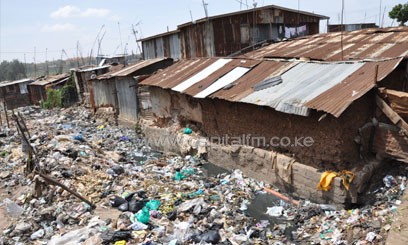
Most slum structures are built with unimproved materials (57 percent of slum dwellings are built with sheet metal and 15 percent of mud and wood) that are cheaper but not suitable for taller buildings/FILE
NAIROBI, Kenya, Feb 10 – Converting informal slums in Nairobi to formal structures would attract investors and increase building volumes by up to 148 percent according to a source quoted in a World Bank Report on African Cities.
In Kibera, for example, the transformation of 1,000 acres covered by the slum to formal structures would inject $1 billion (Sh103 billion) to the economy with the gains used to help relocate tenants and buy off people blocking redevelopment.
“The land is owned by the government but managed by slumlords and political elites who control the land and have no interest in redevelopment (because they do not own the land), which would take away their very profitable slum business,” states the report published by Henderson, Reagan, and Venables.
Converting of informal settlements nearer to the city (less than 2km) would increase building volumes at a higher rate than settlements further from the city, with rate dropping to 53 percent at 4km from the city centre.
The World Bank report, which says African cities are disconnected and closed for business, identifies ineffectual property rights, institutional constraints and capital misallocation as factors that have held back cities from attracting investors and growing.
The also says the dysfunctions in the urban land system distorts the price and availability of land for efficient urban development, prompting recourse to informality in building.
The structure and building materials in informal settlement is also a factor that makes African governments unable to provide affordable formal housing
“Housing and other structures in Africa employ cheap methods that do not allow substituting capital for land,” says the report.
By contrast, in much of developing East Asia — as in developed countries — building methods allow for
various floor areas and building heights.
“In Bangkok, for example, the average height of the tallest buildings is 62 floors; in Kuala Lumpur it is 84 floors. In contrast, in Dar es Salaam it is just 15 floors.”
The report further says African cities fragmented nature and lack of affordable transport imposes high living costs on workers and high labor costs results in indirect costs and other constraints for firms.
African cities, the authors say, “might as well post a ‘closed for business’ sign…and set up an ‘out of service’ as well”



































